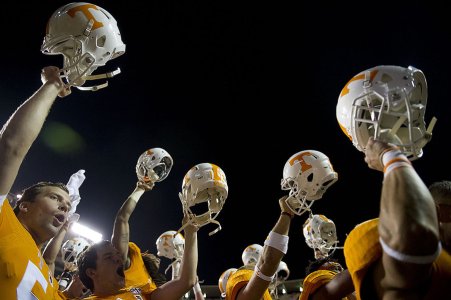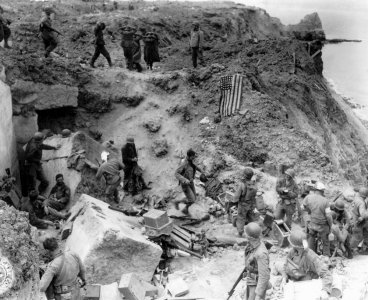I did already have the history part done.
The Normandy Peninsula juts from the coast of France into the English Channel like a finger pointingroughly west.
This morning on the north coast began much like most others. A huge storm had just passed over and the Channel was still roiled by its violence and was a steel-gray color that matched the overcast skies. Otherwise the rhythms that ruled life after four years of German occupation went on … until …
Up and down that coast sleepy German sentries watched the same beaches they'd been watching since they'd arrived from trenches and bunkers along the bluffs. Like sentries since the dawn of history they shifted from foot to foot and wondered when the hell their relief would show up.
Movement attracts the eye. Fuzzy shapes began to emerge in the dim light out of the offshore fog. Ships! Hundreds of them!
Mein Gott!!!
Then flashes began to sparkle up and down that armada. The sentries and watchers never heard the deep booms of naval artillery as the shells flew faster than sound and their positions were submerged in a hurricane of explosions.
It was 6 June 1944.
D-Day.
There were five landing beaches running east to west. On the east were the three British beaches: GOLD, JUNO and SWORD. To the west were the American beaches: OMAHA and UTAH.
Between OMAHA and UTAH a promontory jutted out to the north called
Point du Hoc. On top of the bluffs was a battery of six 155mm guns. From that position they could fire on both OMAHA and UTAH. Bombers blasted the area in the weeks leading up to the landings and naval fire support was scheduled for the morning of D-Day, but the best way to ensure the guns were silenced was to send men up those bluffs to make sure.
The task was assigned to the American 2nd Ranger Battalion.
The Ranger concept dates back to the early colonial era. As conflicts arose between settlers and the native tribes, with attendant atrocities from both sides, tactics evolved. The tribal warriors had long before adopted hit-and-run tactics during conflicts with other tribes. In response, the colonial militia adopted much the same doctrine relying on frontiersmen to teach them how to sneak through the woods to beat the enemy over the head before they could do likewise. Despite having relatively small numbers, these units could, in modern parlance, punch far above their weight.
European generals, for the most part, dismissed irregular warfare as “unsporting”and preferred to line up their armies facing each other at point-blank range and shoot it out. One suspects they also realized that irregulars empower the lower classes and would upset the social order. As that later master of irregular war, Mao, would write, “The guerrilla must move amongst the people as a fish swims in the sea.”One also suspects that the fact that these units were usually led by junior officers caused the beribboned generals to understand that they. too, could be rendered superfluous.
Such linear tactics and thinking were supremely unsuited to military operations in the trackless wilderness of the frontier.
These colonial irregulars became known as “Rangers.”
These units became more and more established as normal parts of colonial militia formations. And so it went for well over a century.
What became known to history as the Seven Years War between Britain and France began in1754. Since the British and French colonies bumped up against each other in North America, it was inevitable that the fighting would cross the Atlantic.
In 1755 a farm boy and sometime counterfeiter from Massachusetts Bay colony named Robert Rogers moved to New Hampshire and offered to raise a company. His offer was accepted and soon Rogers had his company which began to function as rangers.. His personal courage was demonstrated on operations where he also took his company on long-range scouting missions and returned with much-needed intel. Indeed, as English fortunes ebbed Rogers' successes became well known and provided a needed shot in the arm to Colonial morale.
In 1756, he was commissioned as Captain of an “independent company of Rangers”and a legend was born.
Throughout the remainder of the War, “Rogers' Rangers” did yeomanry service scouting, gathering intelligence, attacking isolated French and Indian outposts and disrupting their supplies.
Rogers formalized Ranger training and eventually codified what became known as “Roger's Rules for Rangers.”
1. Don't forget nothing.
2. Have your musket clean as a whistle, hatchet scoured, sixty rounds powder and ball, and be ready to march at a minute's warning.
3. When you're on the march, act the way you would if you was sneaking up on a deer. See the enemy first.
4. Tell the truth about what you see and do. There is an army depending on us for correct information. You can lie all you pleasewhen you tell other folks about the Rangers, but don't never lie to aRanger or officer.
5. Don't never take a chance you don't have to.
6. When we're on the march we march single file, far enough apart so one shot can't go through two men.
7. If we strike swamps, or soft ground, we spread out abreast, so it's hard to track us.
8. When we march, we keep moving 'til dark, so as to give the enemy the least possible chance at us.
9. When we camp, half the party stays awake while the other half sleeps.
10. If we take prisoners, we keep 'em separate 'til we have had time to examine them, so they can't cook up a story between 'em.
11. Don't ever march home the same way. Take a different route so you won't be ambushed.
12. No matter whether we travel in big parties or little ones,each party has to keep a scout 20 yards ahead, twenty yards on each flank and twenty yards in the rear, so the main body can't be surprised and wiped out.
13. Every night you'll be told where to meet if surrounded by superior force.
14. Don't sit down to eat without posting sentries.
15. Don't sleep beyond dawn. Dawn's when the French and Indians attack.
16. Don't cross a river by a regular ford.
17. If somebody's trailing you, make a circle, come back onto your own tracks, and ambush the folks that aim to ambush you.
18. Don't stand up when the enemy's coming against you. Kneel down. Hide behind a tree.
19. Let the enemy come 'till he's almost close enough to touch. Then let him have it and jump out and finish him up with your hatchet.
20. Don't use your musket if you can kill 'em with your hatchet
These rules are branded in the brains of U.S. Army Rangers to this day.
Unfortunately,Rogers sided with the Crown during the American Revolution and raised several Ranger units from Loyalists.
The spirit of the Rangers stayed on with the Colonial forces and inspired men like Ethan Allen in New England and Francis Marion in the Low Country of the Carolinas who tied down great numbers of British regulars. The Over Mountain Men who traveled to King's Mountain and defeated Ferguson were, in essence, Rangers.
Rangers made appearances in the War of 1812 and the Mexican War but then largely disappeared from Army thinking, their place taken by Cavalry units on the frontier and in the American Civil War.
As America prepared to enter World War II, the Army noted that the British were making great use of small, specialized units called “Commandos” after the fast-moving Boer units that drove the British Army nuts during that eponymous war at the turn of the century. The Americans decided they needed similar outfits and reached back into American history and dubbed these highly trained men “Rangers.”
Thus it was that the 2nd Ranger Battalion came to
Pointe du Hoc.
The operation went to worms from the beginning. Weather delayed the run-in by a half hour and therefore the pre-landing bombardment and an air strike were long over by the time the Rangers came ashore. One of the LCAs swamped on the way in and while the crew and Rangers aboard were rescued, the ship that rescued them was heading back to England. A decision was made on the fly that instead of landing on both sides of the promontory, all the Rangers would land on the East side.
On reaching the landing zone they found that short drops and short rounds had cratered the beach that the specialized DUKW amphibious trucks with extension ladders couldn't cross. So the Rangers went up the bluffs using climbing ropes and Jacob's ladders in fits and starts as the Germans at the top fired down at them and dropped grenades. By ones and twos and then fives and tens the Rangers gained the top, quickly organized and moved out toward their objectives. Of the 225 men who landed, roughly 200 made it to the top.
The 5th Ranger Battalion was scheduled to land after the 2nd but, naturally, the radios failed and the signal to land them was never received and they landed on OMAHA and UTAH along with strays form the 2nd. The Rangers were instrumental ing oing up the bluffs at OMAHA and taking out the German machine guns slaughtering the landing force.
They soon discovered that not only were only two of the six concrete gun emplacements completed, NONE of the feared cannons had been mounted. The guns were found under a nearby tree line.
Be that as it may, they quickly over ranthe German defenders who were facing in the wrong direction and prepared for the inevitable counter-attacks and awaited relief from the other beach heads.
The Rangers held out for two more days until finally relieved on 8 June. By that time only 90 Rangers were still standing and many of them were wounded.
It was on UTAH Beach that another key piece of Ranger Lore came into being: the Ranger motto.
According to the story, General Norman Cota, CO of the 29th Infantry Division, button-holed a junior officer at the head of a small unit. Upon being told they were Rangers, Cota snarled, Well, go***mit Rangers, lead the way!” And they did.
The U.S. Army Rangers have served with distinction ever since in every war, alarum and excursion over last 80 years or so.
RANGERS LEAD THE WAY!
Suggested Reading
Col. Robert W. Black,
Ranger Dawn:The American Ranger from the Colonial Era to the Mexican War
Gordon A. Harrison,
Cross ChannelAttack U.S.Army in World War II:European Theater of Operations
War Dept. Historical Division,
SmallUnit Actions
Pointe du Hoc on D+2 (US Army)
View attachment 695599





